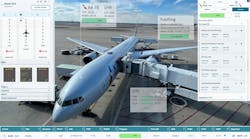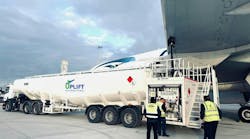Los Angeles International Airport (LAX) was recognized at the 2017 Airports Council International – North America (ACI-NA) Annual Conference for recently achieving Airport Carbon Accreditation (ACA) at Level 3 – Optimization. The ACA program recognizes airports worldwide that are committed to managing their carbon footprint through measurement and reduction with the ultimate goal of carbon neutrality. The higher level certification was announced at ACI-NA’s conference in Dallas, and makes LAX one of only three U.S. airports to be accredited at Level 3 through the ACA program. Van Nuys general aviation airport (VNY) was also recognized with “Level 2 – Reduction” accreditation, and is only one of two general aviation airports in the world accredited at this tier.
“Level 3 accreditation for LAX, and Level 2 for VNY, are important milestones in demonstrating that Los Angeles World Airports is serious about sustainability and protecting our environment,” said Los Angeles Board of Airport Commissioners (BOAC) President Sean Burton. “Reducing our carbon footprint is a critical component of how we ensure that the world’s travelers are able to enjoy sustainable and environmentally responsible airports.”
“Our mission is to serve the world by connecting people, places, and cultures, and we do so with the principles of stewardship and sustainability,” said LAWA Chief Executive Officer Deborah Flint. “The certification of VNY as only one of two general aviation airports in the world at Level 2, and the progress of LAX from Level 2 to Level 3, is a reflection of these principles in all that we do. In our daily operations and in our development programs, we will continue to look at new ways for our airports to reach the gold-standard in environmental sustainability.”
The ACA program recognizes airports worldwide for both reducing and committing to further manage their carbon footprint with the ultimate goal of carbon neutrality. In May 2017, after assessing current and available technologies, and reviewing available financial, operational, and business requirements, VNY committed to 5 percent emissions reduction by 2025, from 2013 levels. ACA Level 2 Reduction accreditation requires airports to quantify their carbon output during a set time period, to submit carbon management plans, and to show progress towards achieving a reduced carbon footprint. Independent verification is conducted biennially to monitor progress towards meeting emissions reduction goals, which are measured against metrics submitted to and approved by the ACA. VNY is committed to ensuring future emissions reductions staff wherever possible, and is investigating opportunities to further implement sustainable practices regarding electricity, natural gas, and fuel consumption in facilities owned and operated by LAWA.
For LAX, ACA Level 3 – Optimization builds off of the requirements set forth for ACA Level 2 – Reduction, which requires an airport to quantify its carbon output during a set time period, submit carbon management plans, and demonstrate progress towards achieving carbon footprint reduction. Level 3 expands the scope of reduction planning to include emissions generated by regulated third-party sources on airports. These include common operational vehicles like aircraft tugs and other ground service equipment (GSE), in addition to buses or shared-ride shuttles that provide guest transportation to and from an airport.
LAX’s achievement of Level 3 accreditation is a result of forward-thinking LAWA policies and collaboration with its airport partners both on and off of the airfield.
"The success of the Airport Carbon Accreditation program is both an inspiration and a challenge to the airport industry," said ACI-NA President and CEO Kevin M. Burke. "While earning certification in this program is difficult, airports must be innovative in finding new ways to reduce carbon emissions in order to renew their certification. I am delighted airports like Los Angeles International and Van Nuys general aviation are continually striving to do their part to be good partners within their communities and in the global aviation system by promoting sustainability and environmentally responsible practices."
On LAX ramps and taxiways, LAWA’s GSE Emissions Reduction Policy, adopted by BOAC in 2015, requires airlines and GSE operators to reduce hydrocarbons (HC) and nitrogen oxide (NOx) emissions to 2.65 grams-per-brake-horsepower-hour (g/bhp-hr) by December 31, 2021 – a 45% reduction from 2006 levels. At the end of 2016, 40 percent of all GSE used at LAX were powered by electricity, and the airport-wide emissions factor was 2.62 g/bhp-hr of NOx and HC – surpassing the 2021 target 5 years ahead of the deadline. LAWA has also installed electrical ground power units (GPUs) at all passenger gates at LAX. These electrified GPUs provide power for parked aircraft, which saves airline pilots from having to use their aircraft’s jet fuel-powered auxiliary power units (APUs), thus reducing carbon emissions and noise.
On the roads that transport guests to and from LAX, the convenient, non-stop FlyAway shuttle service reduced annual vehicle-caused carbon dioxide-equivalent emissions by nearly 7,000 metric tons, while helping travelers avoid over 70,600 vehicle miles traveled per day on trips to and from LAX in 2016. LAWA’s Alternative Fuel Vehicle Program requires all rental car shuttles, truck, and other large commercial vehicles to be powered by alternative fuels.
On LAWA’s buildings and infrastructure, LAWA’s recently adopted Sustainable Design and Construction Policy will require most new buildings and major building renovations to obtain Leadership in Energy and Environmental Design (LEED) Silver certification or better from the US Green Building Council, saving energy, improving efficiency, and thereby reducing greenhouse gas emissions even further.
LAX’s previous Level 2 certification was earned by committing and working to reduce its carbon footprint by 45 percent below 1990 levels by 2025, and by 80 percent by 2050. For 2016, LAX’s GHG emission levels were 16 percent below 1990 levels.





